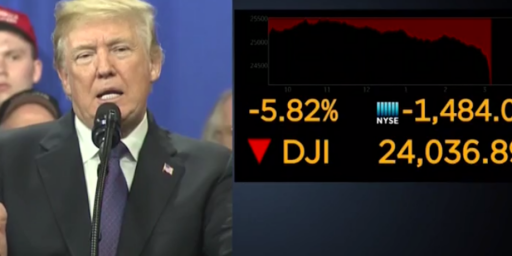No, We Didn’t Give Wall Street $1.5 Trillion
People who should know better are making ridiculous claims.
Yesterday, the Fed pumped a whole bunch of money into the economy in hopes that it would allay panic in the markets arising from the combination of a global pandemic and a crash in oil prices.
I’m seeing a lot of reactions, including from people who really ought know better, along the lines of “With that kind of money, we could wipe out student loan debt . . . .”
I’ll just drop a couple of tweets from well-regarded, left-of-center economists here:
“Horseshit,” of course, is a technical term.
The reporting on this has been drowned out by coronavirus scare. I couldn’t even find a good report on this from NYT or WaPo and WSJ’s, naturally, is paywalled.
The Hill (“Fed to spend $1.5T to pump liquidity into financial markets amid coronavirus panic“):
The New York Fed said in a Thursday statement it will drastically increase the scale of its repurchase (repo) agreements, during which it buys Treasury bonds and other securities from banks and traders with an agreement to sell the product back with interest the following day or soon after.
It will offer $500 billion in repo operations on Thursday followed by $1 trillion in repo agreements Friday “to address highly unusual disruptions in Treasury financing markets associated with the coronavirus outbreak.”
The decision to dramatically increase the scale of Fed repo operations came “pursuant to instruction” from Federal Reserve Chairman Jerome Powell, the New York Fed said in a statement.
The Fed’s bid to refuel financial markets comes amid spiking anxiety among economists and investors about the potential economic toll of the coronavirus outbreak, which the World Health Organization formally designated a pandemic on Thursday.
Business Insider (“Fed announces $1.5 trillion in capital injections to combat coronavirus fallout and ‘highly unusual disruptions’“) gives a more technical breakdown:
The extraordinary funding measure first involves a $500 billion injection at 1:30 p.m. ET on Thursday, the bank said. The cash will be added to money markets through a three-month market repurchase agreement, or repo operation.
One-month and three-month repos for $500 billion each will be conducted on Friday and continue to be offered weekly through the calendar month, the bank added.
The central bank said it would also expand its $60 billion reserve-management purchases to buy up “a range of maturities” roughly matching that seen in Treasury assets outstanding. Securities targeted include Treasury bills, floating-rate notes, and nominal coupons. The first such purchase will begin Friday, the bank said.The Fed’s previously scheduled daily overnight and two-week repos will still take place through the end of the week, adding as much as $220 billion to money markets.
The massive stimulus measure was made in accordance with the Federal Open Market Committee and in response to unprecedented liquidity issues in the Treasury-bond market, the New York Fed said.
“These changes are being made to address highly unusual disruptions in Treasury financing markets associated with the coronavirus outbreak,” the bank said.
There’s not much more the Fed can do on the monetary end to stave off crisis. Which means that we’re relying on the Trump Administration and Congress to work together to come up with something on the monetary side.



Justin Wolfer’s observation (and yours) is correct.
It would be more meaningful if this administration hadn’t already passed a massive tax cut that benefitted primarily big corporations and the ultra rich (except those living in CA, who probably were net neutral on the thing).
We seem dedicated to passing out help to people who don’t really need it. As it turns out, the expansion of the repo market is likely to be needed, since T-bills are nuts right now. As far as I can tell, cash is better than holding a T-bill, and yet people keep buying the things.
@Jay L Gischer: Cash is better if it’s FDIC insured. If not, I can see where T-bills or bonds, even at slightly negative rates, could look attractive. Some people may be skeptical the banks are as well capitalized as they claim.
They have been doing this for awhile.
They already have done about $1/2T…prior to this $1.5T.
The economy isn’t all Trump tells you it is.
@gVOR08: Good point. If you have enough cash, it blows past the FDIC limit. Thanks.
Modern finance is like math, to em at least: past a certain level, I can no longer comprehend what’s going on, much less what to do about it.
If the government were to inject $1.5 trillion into the economy by offering loans for rent / mortgage payments for laid off workers, or for hospital bills would your response be the same?
@gVOR08:
Just a quibble here since I’ve seen this stated several places. The rate on a normal fixed rate treasury is still positive. The negative rate is only on variable rate TIPS treasuries, which means the rate is not fixed and will go up if the rate on future fixed rate bonds goes up.
The fact these are negative is a somewhat positive sign, since it means the people buying them think the market will recover before the bond’s end of term and it will be worth it to forgo money now to get access to that better future rate. If they though the market was going to get worse, they’d go for the fixed rate bond to lock in the current rate.
@Stormy Dragon: Good point. Thx.
@de stijl:
It’s apples and oranges.
I think doing that might well be good policy under the current circumstances. I called for that sort of thing vice corporate bailouts back in 2008.
But, in this instance, it’s literally a series of 24-hour loans. (It turned out that most of the bailout money was paid back with interest, too, but that was hardly obvious at the outset.)
@Jay L Gischer:
Joyner, you are right…
We gave the market 5 trillion dollars.
After the overnight lending market crashed in late 2019, the inept administration put a 60 billion bandaid on a severe cut needing stitches.
Now, in a few months, we have to put 200 billion+ to cover the wound, which now has become infected with sepsis.
The root of the problem is that entities are simply not buying our debt notes, so the administration is using the overnight lending market to fill the unpaid gap, which is growing….and growing…..and growing…..